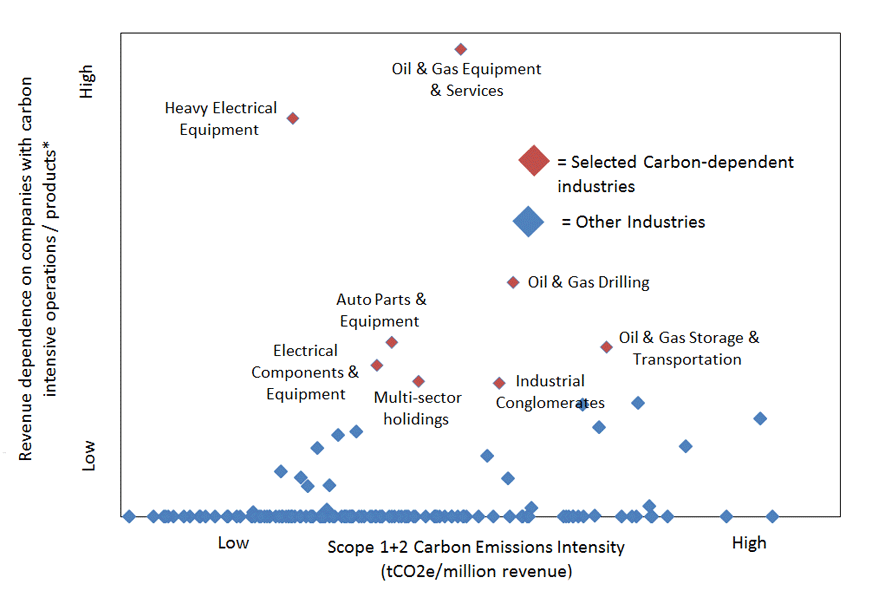Investment Risks in Carbon-Dependent Industries

*This chart highlights average Scope 1+2 carbon emissions intensity for all GICS Sub-industries and their revenue dependence on companies with carbon intensive operations and /or products. It includes revenue a company derives from following business activities: oil & gas equipment & services, oil & gas trading, thermal power plant turbine manufacturing, auto-components such as carburator, piston, piston rings, valves, & electrical equipment for internal combustion engines. Values on both horizontal and vertical axis are plotted on logarithmic scale.
Oil & Gas Equipment & Services | GICS Sub-industry percentile score | Commentary |
|---|---|---|
Oil & Gas Equipment & Services John Wood Group PLC | GICS Sub-industry percentile score 100 | Commentary Diversification into clean energy solutions especially after AMEC FW acquisition, strong carbon risk management efforts |
Oil & Gas Equipment & Services Dialog Group Berhad | GICS Sub-industry percentile score 12.5 | Commentary Limited diversification to low carbon solutions, average carbon risk management efforts |
Oil & Gas Equipment & Services Heavy Electrical Equipment | GICS Sub-industry percentile score GICS Sub-industry percentile score | Commentary Commentary |
Oil & Gas Equipment & Services Siemens Gamesa Renewable Energy, S.A. | GICS Sub-industry percentile score 83.3 | Commentary Involved in fabrication of wind turbines and the construction of wind farms |
Oil & Gas Equipment & Services Bharat Heavy Electricals Limited | GICS Sub-industry percentile score 0 | Commentary Primarily a thermal power plant equipment manufacturer |
Oil & Gas Equipment & Services Auto Parts & Equipment | GICS Sub-industry percentile score GICS Sub-industry percentile score | Commentary Commentary |
Oil & Gas Equipment & Services Valeo S.A. | GICS Sub-industry percentile score 96.3 | Commentary Strong response to low carbon transition by adjusting its product portfolio to electric vehicle trends |
Oil & Gas Equipment & Services NGK Spark Plug Co. Ltd. | GICS Sub-industry percentile score 3.7 | Commentary High exposure to internal combustion engine related components, low efforts in terms of adjusting its product portfolio to electric vehicle trends |
For institutional investors looking to manage their portfolio exposure to the low carbon transition, they may seek to take into account both the direct and indirect risks facing companies as well as the climate change risk of carbon-dependent industries.
Subscribe todayto have insights delivered to your inbox.
The content of this page is for informational purposes only and is intended for institutional professionals with the analytical resources and tools necessary to interpret any performance information. Nothing herein is intended to recommend any product, tool or service. For all references to laws, rules or regulations, please note that the information is provided “as is” and does not constitute legal advice or any binding interpretation. Any approach to comply with regulatory or policy initiatives should be discussed with your own legal counsel and/or the relevant competent authority, as needed.
